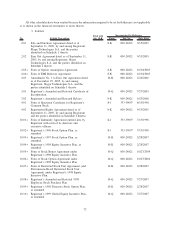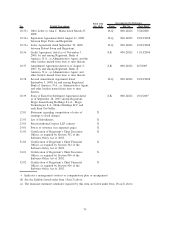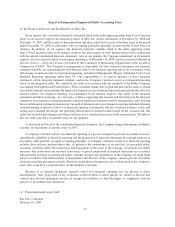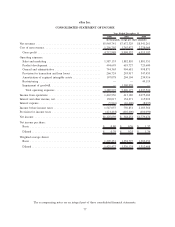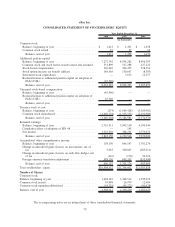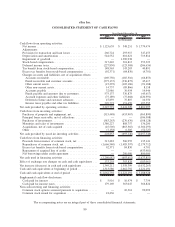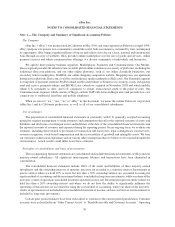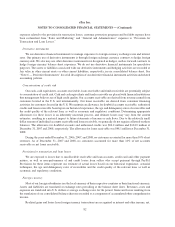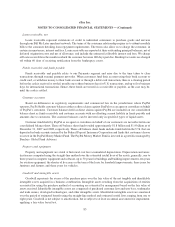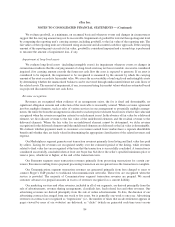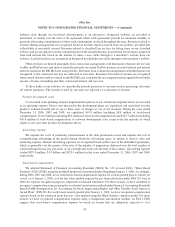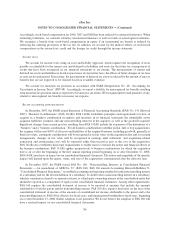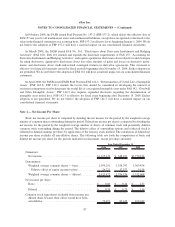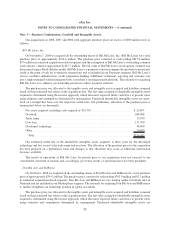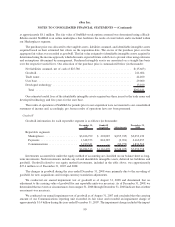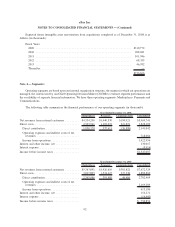eBay 2008 Annual Report Download - page 90
Download and view the complete annual report
Please find page 90 of the 2008 eBay annual report below. You can navigate through the pages in the report by either clicking on the pages listed below, or by using the keyword search tool below to find specific information within the annual report.expenses related to the provision for transaction losses, customer protection programs and bad debt expense have
been reclassified from “Sales and Marketing” and “General and Administrative” expenses to “Provision for
Transaction and Loan Losses.”
Derivative instruments
We use derivative financial instruments to manage exposures to foreign currency exchange rates and interest
rates. Our primary use of derivative instruments is through foreign exchange currency contracts to hedge foreign
currency risk. We also may use other derivative instruments not designated as hedges, such as forward contracts to
hedge foreign currency balance sheet exposures. We do not use derivative financial instruments for speculative
purposes. The assets or liabilities associated with our derivative instruments and hedging activities are recorded at
fair value in other current assets or other current liabilities, respectively, in our consolidated balance sheet. See
“Note 6 — Derivative Instruments” for a full description of our derivative financial instrument activities and related
accounting policies.
Concentrations of credit risk
Our cash, cash equivalents, accounts receivable, loans receivable and funds receivable are potentially subject
to concentration of credit risk. Cash and cash equivalents and funds receivable are placed with financial institutions
that management believes are of high credit quality. Our accounts receivable are derived from revenue earned from
customers located in the U.S. and internationally. Our loans receivable are derived from consumer financing
activities for customers located in the U.S. We maintain an allowance for doubtful accounts receivable, authorized
credits and loans receivable based upon our historical experience, the age and delinquency rates of receivables and
the credit quality of the relevant loan, as well as economic and regulatory conditions. Determining appropriate
allowances for these losses is an inherently uncertain process, and ultimate losses may vary from the current
estimates, resulting in a material impact to future statements of income or cash flows. Due to the relatively small
dollar amount of individual accounts receivable and loans receivable, we generally do not require collateral on these
balances. The allowance for doubtful accounts and authorized credits was $96.2 million and $104.9 million at
December 31, 2007 and 2008, respectively. The allowance for loans receivable was $48.1 million at December 31,
2008.
During the years ended December 31, 2006, 2007, and 2008, no customers accounted for more than 10% of net
revenues. As of December 31, 2007 and 2008, no customers accounted for more than 10% of net accounts
receivable or net loans receivable.
Provision for transaction and loan losses
We are exposed to losses due to uncollectible receivable and loan accounts, credit card and other payment
misuse, as well as non-performance of and credit losses from sellers who accept payment through PayPal.
Provisions for these items represent our estimate of actual losses based on our historical experience, actuarial
techniques, the age and delinquency rates of receivables and the credit quality of the relevant loan, as well as
economic and regulatory conditions.
Foreign currency
Most of our foreign subsidiaries use the local currency of their respective countries as their functional currency.
Assets and liabilities are translated at exchange rates prevailing at the balance sheet dates. Revenues, costs and
expenses are translated into U.S. dollars at average exchange rates for the period. Gains and losses resulting from
the translation of our consolidated balance sheet are recorded as a component of accumulated other comprehensive
income.
Realized gains and losses from foreign currency transactions are recognized as interest and other income, net.
82
eBay Inc.
NOTES TO CONSOLIDATED FINANCIAL STATEMENTS — (Continued)


